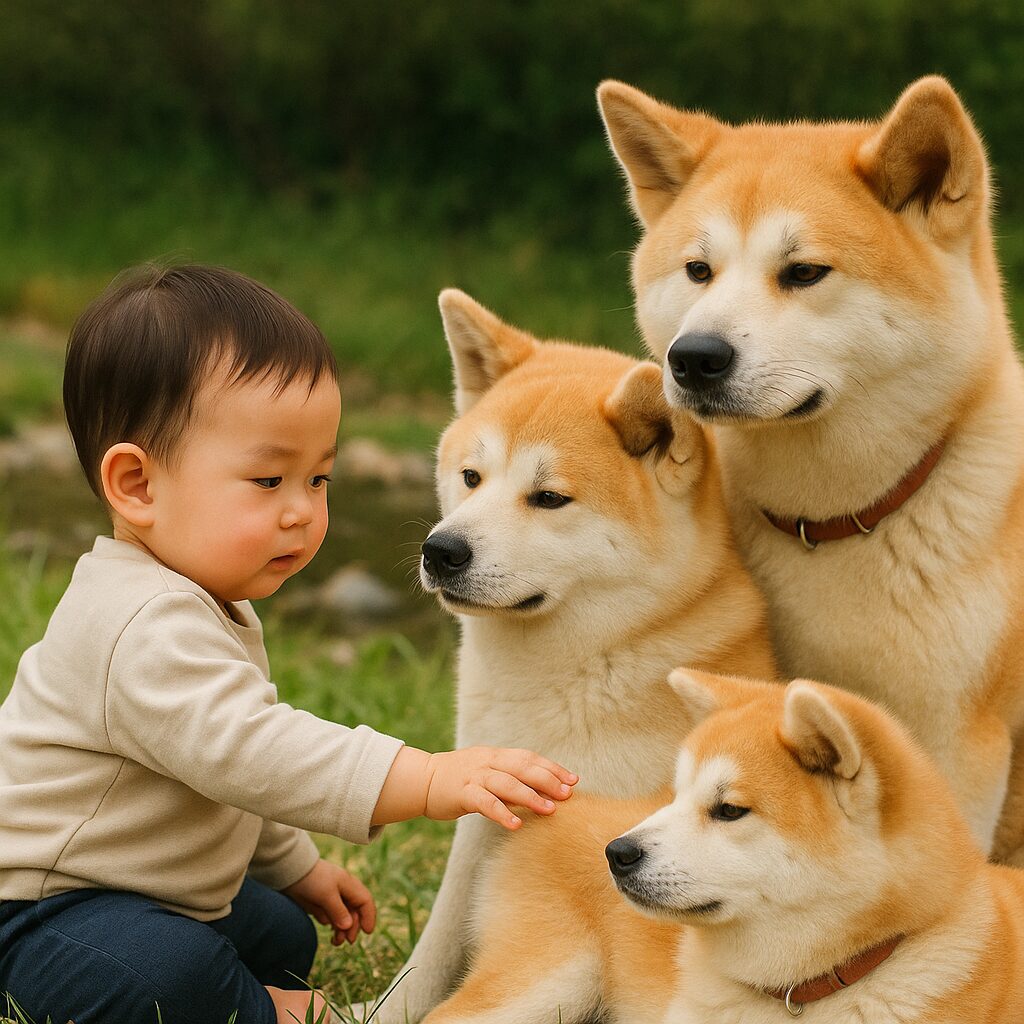On a quiet afternoon in Japan, a simple encounter between a toddler and two Akita dogs unfolded into something unforgettable. The boy was just one year old, still unsteady on his feet, yet his curiosity pushed him forward. With soft, tiny hands he reached out to greet Momo, one of the Akitas. The dog did not move away or flinch. Instead, she leaned into the touch, embodying patience. A moment later, the child turned toward Sakura, who stood calmly nearby, her watchful eyes radiating both gentleness and strength.
The scene lasted only minutes, but its impact spread far beyond the family who witnessed it firsthand. A video clip of the encounter, later shared online, was met with comments describing it as “pure peace,” “a traffic jam of cuteness,” and “the definition of harmony.” To many, this moment represented something deeper than just a child meeting two dogs. It embodied trust — the kind of trust that is built between species over centuries of companionship.
Why This Moment Matters
In Japan, the Akita breed carries rich cultural significance. Known for their loyalty, dignity, and quiet protectiveness, Akitas have long been celebrated as family guardians. Stories like that of Hachikō, the Akita who waited faithfully at Shibuya Station for nearly a decade after his owner’s death, highlight the breed’s reputation for unyielding devotion. To see two Akitas offering such calm patience to a fragile, curious toddler is to witness that legacy alive in the present day.
For many viewers, the video resonated because it spoke to the possibility of coexistence. In a world that often feels hurried and fractured, here was a picture of harmony: innocence meeting loyalty, curiosity meeting patience. A child too young to speak yet somehow understood he was safe, and two large dogs trusted enough to respond with tenderness rather than dominance.
The Unique Nature of Akitas
Akitas are not always easy companions. They are known for their independence, intelligence, and occasional stubbornness. Unlike breeds that eagerly seek to please, Akitas often choose moments of engagement on their own terms. Yet, when properly socialized and respected, they display a remarkable blend of restraint and protectiveness.
Sakura and Momo’s calm behavior did not appear overnight. Behind that moment was likely a thoughtful routine of socialization, exposure, and gentle training. Their family probably introduced them to children slowly, rewarded them for patience, and ensured that interactions were supervised. This preparation turned what could have been a risky encounter into a living demonstration of what responsible pet ownership can achieve.
The Science of Calm Interactions
Animal behaviorists note that dogs mirror the energy of their environment. Toddlers often move quickly, make unpredictable sounds, and grab without warning — behaviors that can make many dogs anxious. What makes this story remarkable is how Sakura and Momo held steady in the face of such unpredictability.
This steadiness suggests a high level of emotional regulation, nurtured by their upbringing. It also reflects the Akita’s natural temperament: while alert and protective, they are often deeply attuned to their surroundings, responding less with frantic energy and more with quiet watchfulness. For the child, this created a bubble of calm in which he could explore without fear.
Cultural Reflections
In Japan, harmony (和, wa) is a cherished value, emphasized in daily life, relationships, and traditions. The video of a child meeting two Akitas captured this ideal. The moment was not staged, nor was it elaborate. Its power came from simplicity: a boy, two dogs, and a shared stillness that viewers recognized as a reflection of something larger.
Such images matter because they challenge stereotypes. Large dogs are often viewed as intimidating around children, yet here were two powerful Akitas showing patience so profound it felt almost ceremonial. The message was clear: respect between species can create peace.
Lessons for Families
For those raising children alongside dogs, this story offers both inspiration and guidance.
-
Supervision is essential. Even calm dogs should never be left unsupervised with young children. The magic of moments like this depends on careful oversight.
-
Teach gentle touch early. Children can learn to stroke slowly, avoid pulling fur, and respect a dog’s space.
-
Respect the dog’s signals. If a dog turns away, stiffens, or avoids eye contact, it is communicating discomfort. Pausing the interaction honors that communication.
-
Celebrate small successes. Just a few seconds of calm contact is progress. Over time, these moments can grow into lasting trust.
By following such principles, families can create their own stories of harmony — ones that echo the peaceful meeting of Sakura, Momo, and the little boy.
The Emotional Takeaway
What made this encounter resonate with thousands wasn’t just the cuteness of a toddler and two fluffy Akitas. It was the glimpse of what happens when love, patience, and respect guide our relationships with animals. A boy too young to speak found language in touch. Two dogs bred for strength chose gentleness instead.
For many who watched, it was a reminder of what we yearn for in daily life: calm, trust, and the assurance that even in a world full of noise, peace is possible.
And so the moment lingers — not just as a viral video, but as a small parable about connection. Sometimes, the most profound lessons in trust and harmony come not from words, but from a child’s hand resting gently on the fur of a dog who simply waits.

